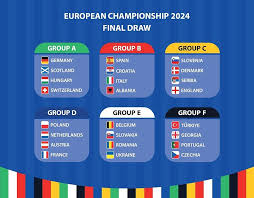Understanding the Fußball-Europameisterschaft Tabelle: A Comprehensive Guide

Introduction to Fußball-Europameisterschaft Tabelle
The Fußball-Europameisterschaft Tabelle, often referred to as the Euro table, is a crucial framework for understanding the standings and performance of national teams during the UEFA European Championship. This prestigious tournament, held every four years, gathers the top football nations in Europe to compete for the coveted title. The table serves as a concise representation of each team’s journey, showcasing their victories, losses, draws, and points accumulated throughout the competition.
Understanding the Fußball-Europameisterschaft Tabelle is essential for fans, analysts, and teams alike. It not only indicates which teams are likely to advance to the knockout stages but also reflects the overall competitive landscape of European football. Each match contributes to the table’s dynamic nature, providing insights into team form, strategies, and potential matchups. For supporters, following the progression of their national team through the table is an exhilarating experience that heightens the engagement with the tournament.
The significance of the table extends beyond mere numbers; it embodies the aspirations of nations. Teams aim to secure a favorable position, as this directly affects their route towards the final stages of the championship. The table is an essential tool for evaluating performance against rivals, making tactical adjustments, and understanding the implications of each result. For instance, a single loss could alter a team’s standing dramatically, influencing qualification for subsequent tournaments.
In addition to its competitive aspects, the Fußball-Europameisterschaft Tabelle fosters a sense of unity among fans. It creates a shared narrative that encapsulates the excitement and drama of the tournament, sparking discussions, analyses, and debates within the football community. As the tournament progresses, the evolving dynamics of the table become a focal point for immense passion and interest, highlighting the unique character of European football.
The Format of the Fußball-Europameisterschaft
The Fußball-Europameisterschaft, or UEFA European Championship, features a structured format that consists of group stages followed by knockout rounds. Understanding this format is essential to grasp how the tournament unfolds and how the teams progress through the various stages. Initially, the competition begins with a group stage, typically comprising 24 teams divided into six groups of four. Each team plays the others in its group once, and matches yield points: three for a win, one for a draw, and none for a loss. The teams are then ranked in the fußball-europameisterschaft tabelle based on their point totals, with goal difference and goals scored serving as tiebreakers where necessary.
Following the conclusion of the group stage, the top two teams from each group, alongside the four best third-placed teams, advance to the knockout rounds. This single-elimination phase intensifies the competition and features a series of matchups culminating in the final. Knockout matches can end in a tie, which leads to extra time and, if necessary, a penalty shootout to determine the winner. Throughout this phase, the stakes are elevated, as every match can ultimately determine whether a team continues its pursuit of the championship.
The design of the tournament allows for an exciting progression within the Fußball-Europameisterschaft tabelle, as teams strive not only to secure advancement to the knockout phases but also to position themselves strategically for favorable matchups. As fans track their favorite teams, the continuous updates to the table serve as a dynamic reflection of the tournament’s intensity. By understanding the structure of both the group stage and the knockout phase, one can appreciate the intricate path that teams must navigate to reach the coveted final match and ultimately claim the title.
Understanding the Points System
The points system in the Fußball-Europameisterschaft Tabelle is crucial for determining team rankings during the tournament. Each match outcome contributes to the overall standings, influencing which teams progress to the knockout stages or ultimately compete for the title. In this system, teams are awarded points based on their performance in each match: three points are awarded for a win, one point for a draw, and no points for a loss. This straightforward structure encourages teams to strive for victories, as accumulating points directly correlates with their chances of advancing.
For instance, a team that wins two matches and loses one will earn a total of six points, while a team that draws three matches would accumulate three points. The significance of these points intensifies as the tournament progresses; every match can impact a team’s position within their group, making it essential for them to perform consistently well. The Fußball-Europameisterschaft Tabelle not only reflects these points but also the overall competitiveness of each group, as teams jockey for the best placements.
In cases where teams finish the group stage with the same number of points, a series of tiebreakers come into play to determine their rankings. The first criteria involve goal difference, where the total goals scored minus the total goals conceded are evaluated. If teams are still tied, then the number of goals scored overall is considered. Should there still be no resolution, the next criteria involve examining disciplinary records and, if necessary, head-to-head results from the matches played between the tied teams. This comprehensive approach underscores why every single match is vital; one goal can change the fate of a team’s journey through the tournament.
Significant Historical Context
The Fußball-Europameisterschaft, commonly referred to as the UEFA European Championship, has undergone considerable evolution since its inception in 1960. Initially conceived as a smaller tournament, the competition has significantly expanded in scope and importance, culminating in a dynamic landscape where the fußball-europameisterschaft tabelle becomes a focal point of interest for fans and analysts alike. The tournament reflects not just a contest of footballing prowess, but also the shifting political and cultural landscape of Europe over the decades.
Early editions of the tournament were marked by dominance from teams like the Soviet Union and later, Germany. However, historical shifts, including the emergence of new footballing nations and changes in tactical approaches, have altered the competitive narrative. The introduction of the group stage in 1980 allowed more teams to participate, making the fußball-europameisterschaft tabelle a comprehensive showcase of European talent. This format change catalyzed thrilling matches, new rivalries, and unforgettable moments that continue to resonate with fans today.
Key teams have emerged from various eras, each contributing to the legacy of the tournament. For instance, France’s victory in 1984 marked the beginning of a golden age for French football, while Greece’s triumph in 2004 was a stunning upset that reshuffled the expectations within the competition. The evolving dynamics of power have prompted discussions not only about the fußball-europameisterschaft tabelle but also about each country’s growth in technical and tactical capabilities. Such shifts ensure that each tournament carries its own unique stories of underdogs and favorites, reflecting the ever-changing nature of European football.
Current Trends in the Fußball-Europameisterschaft Tabelle
The Fußball-Europameisterschaft Tabelle has seen exciting trends evolve over recent tournaments, reflecting both the rising competitiveness of teams and a shift in playing styles. Teams that were once considered underdogs have made significant strides, showcasing a marked improvement in performance and strategy, which has impacted their standings in the current tournament’s table.
Historically, powerhouses like Germany, France, and Italy have dominated the leaderboard. However, the recent contests have highlighted a broader array of top-performing nations, indicating that traditional trajectories may no longer be as predictable. For instance, nations such as Belgium and Portugal have consistently showcased formidable talent and tactical prowess, often challenging established norms of the tournament hierarchy.
Data from the ongoing 2023 tournament provides further insights into current trends. Teams are demonstrating greater reliance on youth talent, with many national squads integrating younger players into their line-ups. This shift has not only revitalized the teams but has also led to remarkable agility and innovative play styles on the field. Analyzing the current fußball-europameisterschaft tabelle, one can see that these youthful squads have contributed to surprising upsets, altering the expected outcomes in several matches.
Furthermore, advancements in sports science and technology have greatly influenced team performance. An emphasis on physical fitness and analytics has allowed teams to prepare in a more informed manner, giving them a competitive edge. Clubs increasingly focus on scouting and recruitment strategies aimed at identifying promising talents in earlier stages, boosting their chances of succeeding on the international stage.
By examining both recent outcomes and historical data, it becomes clear that the current trends evident in the fußball-europameisterschaft tabelle highlight an evolving competitive landscape. As teams adapt to these changes, fans and analysts alike will be keenly watching to see how these dynamics unfold in future tournaments.
How to Interpret the Table
Understanding the Fußball-Europameisterschaft Tabelle requires a keen eye for detail and an appreciation of the various metrics that influence team positions. The table primarily lists teams based on their performance in the tournament, typically arranged by points, which are earned through wins and draws. Each win typically contributes three points, while a draw yields one point. This straightforward points system forms the basis for ranking teams.
In addition to points, goal difference is a critical metric that can affect a team’s standing. Goal difference is calculated by subtracting the total number of goals conceded from the total goals scored. A team with a greater number of goals scored than goals conceded will have a positive goal difference, which can act as a tie-breaker when teams have equal points. Hence, goal difference can be significant in tightly contested tournaments where several teams are in close proximity within the table.
Another important aspect to consider is the number of games played, as this often provides context to a team’s position in the Fußball-Europameisterschaft Tabelle. For instance, a team that has played fewer matches may still have the potential to gain points and shift their ranking positively. As such, looking ahead to remaining fixtures can provide insights into which teams are likely to rise or fall in the standings. Understanding the implications of upcoming matches is crucial for fans tracking their favorite teams.
Finally, injuries to key players, team form, and recent performances can also influence how the table evolves over the course of the tournament. By interpreting all these factors collectively, fans can gain a more comprehensive understanding of not just where a team stands, but what the future may hold in terms of their success in the tournament.
Impact of the Tabelle on Fans and Teams
The Fußball-Europameisterschaft tabelle serves not merely as a statistical representation of team performance but also plays a pivotal role in shaping the emotional landscape surrounding the tournament. For fans, each update on the table can be a source of excitement and apprehension. A team’s position in the standings can elicit a range of emotions, from the jubilation of a victory to the despair of a loss, reflecting the direct relationship between the supporters and their team’s progression through the tournament.
The anticipation of every match and its effect on the Fußball-Europameisterschaft tabelle creates an atmosphere of anxiety among fans. They often find themselves engaged in discussions about potential outcomes, contemplating what each match means for their team’s chances of advancing. This engagement fosters a sense of belonging and community, as fans often gather in homes, pubs, or parks to share in both the highs and lows of the matches. Thus, the table serves as a compelling focal point around which social interactions are built, enhancing the collective experience of the tournament.
Teams themselves are not immune to the pressures of their standing in the Fußball-Europameisterschaft tabelle. Coaches and players feel the weight of expectations that come with their position, particularly if they find themselves contending for a top place or struggling to avoid elimination. The psychological impact of the table can affect team morale, influencing performance on the pitch. High-ranking positions may bolster confidence, while those in lower slots may induce stress or pressure to perform. Consequently, the interplay between the tabelle, team dynamics, and fan excitement demonstrates the integral relationship that exists within the framework of the tournament.
Future of the Fußball-Europameisterschaft Tabelle
The Fußball-Europameisterschaft Tabelle, a crucial tool for assessing team performance in one of football’s most prestigious tournaments, may undergo significant transformations as the sport evolves. As we look ahead, it is essential to consider how potential changes to tournament structure, format, and rules might impact the functionality of this table, making it both a historical reference and a dynamic element of international football.
One of the most promising prospects is the potential expansion of the tournament format. Recent discussions among football governing bodies suggest an increase in the number of participating teams, which could shift the current ranking criteria. This modification would not only enhance competition but could also affect how the fußball-europameisterschaft tabelle is organized, potentially incorporating new metrics to evaluate performance across a more extensive field of participants.
Moreover, advancements in technology could lead to innovative ways of presenting the fußball-europameisterschaft tabelle. For instance, adopting data analytics and artificial intelligence may provide deeper insights into team strategies, player performances, and match statistics. This data-driven approach could refine how points are awarded and measured, shifting the emphasis from traditional metrics to more intricate assessments of overall contributions to a team’s success.
Additionally, the incorporation of VAR (Video Assistant Referee) decisions and their implications on match outcomes may necessitate adjustments in table calculations, ensuring fairness and accuracy in rankings. As international football continues to adapt, there may also be a push for uniformity across European leagues, leading to a more standardized approach in the fußball-europameisterschaft tabelle and its associated rules.
Ultimately, as we envision the future of the Fußball-Europameisterschaft Tabelle, it is clear that the interplay of innovation, structure, and technology will shape the landscape of international football, transforming not only how teams are ranked but also how fans engage with the tournament’s rich history.
Conclusion and Final Thoughts
In this comprehensive guide, we have delved deep into the concept of the Fußball-Europameisterschaft Tabelle, highlighting its crucial role in understanding the dynamics of the European football championships. The table not only outlines the standings of participating teams but also reflects the competitive spirit of the tournament, influencing how fans and analysts perceive team performances throughout the event.
The significance of the Fußball-Europameisterschaft Tabelle extends beyond mere numbers; it encapsulates the excitement and unpredictability of the matches. As teams vie for top positions, the movements within the table can create dramatic shifts in strategies, fan engagement, and even regional pride among supporters. Each point earned or lost carries substantial weight, altering the trajectory of teams as they aim for glory on the European stage.
Moreover, this table serves as a vital tool for fans, media, and stakeholders alike, allowing for insightful analysis of performances, potential match outcomes, and historical comparisons. Understanding the nuances of the table enables fans to engage more deeply with the competition, as every match becomes pivotal in determining the eventual victor of this prestigious event. The anticipation built around the table’s evolving nature contributes significantly to the overall viewing experience.
We encourage readers to stay actively engaged with the Fußball-Europameisterschaft Tabellen and the ongoing tournament. Embrace the highs and lows of your favorite teams, and appreciate how the table shifts as matches unfold. By doing so, one can truly relish the spirit of European football and the narratives that come alive during the championship. As the competition progresses, the table will undoubtedly tell its own story, reflecting the determination and skill of Europe’s footballing elite.
Sie können dies auch lesen munichblock

